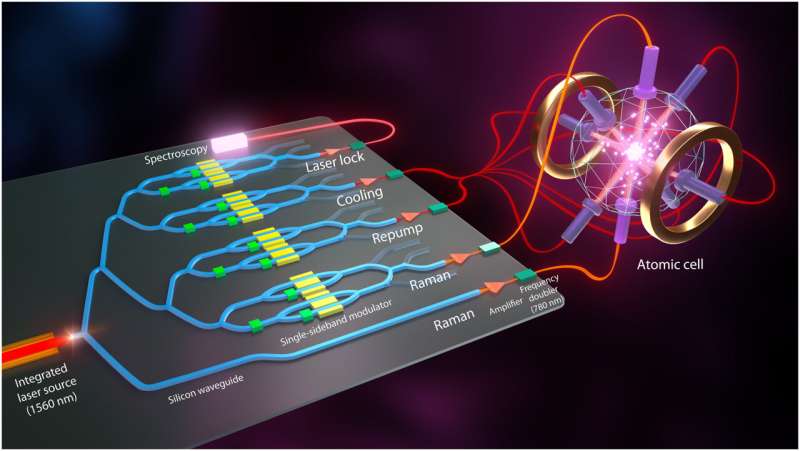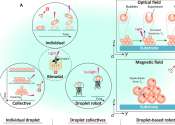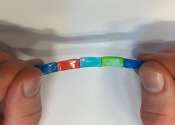For the first time, researchers from Sandia National Laboratories have used silicon photonic microchip components to perform a quantum sensing technique called atom interferometry, an ultra-precise way of measuring acceleration. It is the latest milestone toward developing a kind of quantum compass for navigation when GPS signals are unavailable.
Quantum sensing milestone draws closer to exquisitely accurate, GPS-free navigation

The team published its findings and introduced a new high-performance silicon photonic modulator—a device that controls light on a microchip—as the cover story in the journal Science Advances.
- The research was supported by Sandia's Laboratory Directed Research and Development program.
- It took place, in part, at the National Security Photonics Center, a collaborative research center developing integrated photonics solutions for complex problems in the national security sector.
GPS-free navigation a matter of national security"Accurate navigation becomes a challenge in real-world scenarios when GPS signals are unavailable," said Sandia scientist Jongmin Lee.In a war zone, these challenges pose national security risks, as electronic warfare units can jam or spoof satellite signals to disrupt troop movements and operations.Quantum sensing offers a solution.
Typically, an atom interferometer is a sensor system that fills a small room. A complete quantum compass—more precisely called a quantum inertial measurement unit—would require six atom interferometers.
- But Lee and his team have been finding ways to reduce its size, weight and power needs.
- They have already replaced a large, power-hungry vacuum pump with an avocado-sized vacuum chamber and consolidated several components usually delicately arranged across an optical table into a single, rigid apparatus.
- However, modulators often create unwanted echoes called sidebands that need to be mitigated.
- Sandia's suppressed-carrier, single-sideband modulator reduces these sidebands by an unprecedented 47.8 decibels—a measure often used to describe sound intensity but also applicable to light intensity—resulting in a nearly 100,000-fold drop.
Besides size, cost has been a major obstacle to deploying quantum navigation devices. Every atom interferometer needs a laser system, and laser systems need modulators.
- Miniaturizing bulky, expensive components into silicon photonic chips helps drive down these costs.
- Researchers are investigating whether it could help locate underground cavities and resources by detecting the tiny changes these make to Earth's gravitational force.
- They also see potential for the optical components they invented, including the modulator, in LIDAR, quantum computing and optical communications.
Lee and Kodigala represent two halves of a multidisciplinary team.
- One half, including Lee, consists of experts in quantum mechanics and atomic physics.
- The other half, like Kodigala, are specialists in silicon photonics—think of a microchip, but instead of electricity running through its circuits, there are beams of light.
"We have colleagues that we can go down the hall and talk to about this and figure out how to solve these key problems for this technology to get it out into the field," said Peter Schwindt, a quantum sensing scientist at Sandia.
The National Security Photonics Center collaborates with industry, small businesses, academia and government agencies to develop new technologies and help launch new products. Sandia has hundreds of issued patents and dozens more in prosecution that support its mission.
"I have a passion around seeing these technologies move into real applications," Schwindt said.
Michael Gehl, a Sandia scientist who works with silicon photonics, shares the same passion. "It's great to see our photonics chips being used for real-world applications," he said.
Science Advances is a peer-reviewed multidisciplinary open-access scientific journal established in early 2015. It is the first open-access journal published by the American Association for the Advancement of Science. It was announced in February 2014, and published its first articles in early 2015.
More information: Ashok Kodigala et al, High-performance silicon photonic single-sideband modulators for cold-atom interferometry, Science Advances (2024). DOI: 10.1126/sciadv.ade4454
ELECTRONICS & SEMICONDUCTORS

Quantum sensing milestone draws closer to exquisitely accurate, GPS-free navigation
Peel apart a smartphone, fitness tracker or virtual reality headset, and inside you'll find a tiny motion sensor tracking its position and movement. Bigger, more expensive versions of the same technology, about the size of ...
18 HOURS AGO
0
41
ELECTRONICS & SEMICONDUCTORS

Full-color fiber LEDs created with perovskite quantum wires pave way for advanced wearable displays
A research team led by the School of Engineering of the Hong Kong University of Science and Technology (HKUST) has developed full-color fiber light-emitting diodes utilizing perovskite quantum wires (PeQWs), paving the way ...
AUG 12, 2024
0
14
MACHINE LEARNING & AI

Researchers develop next-gen semiconductor technology for high-efficiency, low-power artificial intelligence
A research team has demonstrated that analog hardware using ECRAM devices can maximize the computational performance of artificial intelligence, showcasing its potential for commercialization. Their research has been published ...
AUG 1, 2024
0
30
ROBOTICS

Researchers use light to control ferrofluid droplet movements in water
A team of engineers at the Max Planck Institute for Intelligent Systems, the Chinese University of Hong Kong and the Gwangju Institute of Science and Technology has found that ferrofluidic drops in a tank of water can be ...
ELECTRONICS & SEMICONDUCTORS

Soft, stretchy 'jelly batteries' inspired by electric eels
Researchers have developed soft, stretchable 'jelly batteries' that could be used for wearable devices or soft robotics, or even implanted in the brain to deliver drugs or treat conditions such as epilepsy.
JUL 17, 2024
0
65
ENGINEERING

Engineers develop technique to pinpoint nanoscale 'hot spots' in electronics to improve their longevity
When electronic devices like laptops or smartphones overheat, they are fundamentally suffering from a nanoscale heat transfer problem. Pinpointing the source of that problem can be like trying to find a needle in a haystack.
JUL 17, 2024
0
1


No comments:
Post a Comment